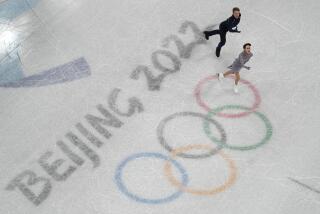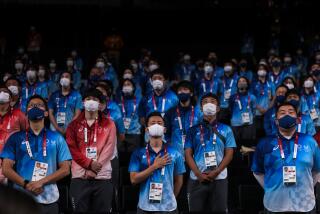Pin Trading: Hot Olympic Pastime : It Started in 1896, Flowered During 1984 Summer Games
- Share via
SEOUL, South Korea — Outside the Hall of Athletes, the glittering heart of the Olympic Village, American tennis pro Pam Shriver videotapes the pinheads.
The most popular Olympic pastime--swapping team and country pins--is hotter than the noonday sun. And not just in the athletes’ home away from home. The same scene goes on at competition sites and across the Han River in It’aewon, Seoul’s alley-pocked mecca for bargain hunters.
Shriver, a member of the U.S. women’s tennis team, keeps taping until five other pinheads--the name pin traders wear with pride--spot a dozen emblems on her USA cap. In minutes, her scant supply of U.S. tennis pins is gone.
“I’ve got to get more pins to trade. I’m getting away with my life, that’s about it,” Shriver said. “They’re so aggressive.”
Pin-swapping dates back to 1896 for Olympic insiders--athletes, officials and the media. It flowered as a spectator phenomenon during the 1984 Summer Games. Swapping and sales tents were set up in Los Angeles for 20,000 collectors. The Winter Games in Calgary, Canada, last February drew an estimated 300,000 pin collectors. The number of pins in circulation is in the millions just in this 24th Olympiad.
Former University of Arizona marketing professor Bill Nelson’s Tucson mail order business has grown into the largest pin distributorship in the United States. Even Nelson, whose newsletter reaches 52,000 subscribers, can’t explain all the interest.
“I taught consumer behavior for a number of years and I just don’t know,” Nelson says.
“It is a token of goodwill, friendship and understanding. When athletes go to the Olympics, the criterion is that you be a good athlete. Many come from poor countries. What can they give to somebody? They’re not going to give the shirt off their back because they may only have one shirt. So they give a pin, which can bring back memories.”
For the first time in Summer Games history, an official opening ceremonies pin was distributed to all participants and spectators. The design by 9-year-old Park Seung-ji of Yeochon City, Korea, features three hands of different colors, clasped in friendship.
Nearly every country has a pin. The Soviets call theirs “znachki.” Many countries have a different pin for each sport. Media organizations have pins, as do the Games’ corporate sponsors. Many Korean and sponsor pins feature Hodori, the orange tiger cub who is the Olympic mascot.
Most are coated with enamel paint and clear acrylics. The best have cloisonne enamel: powdered, colored glass that is mixed with water, brushed into the pin face and heated in a furnace.
There’s a din of international bartering, the bustle of an open-air bazaar in the athlete’s village. Bulgarian wrestler Ilia Gueorguiev holds up a 1-square-foot cloth covered with pins. He says nothing. If a trade is acceptable, he nods. If not, he shakes his head. When one pin won’t suffice, he raises two fingers.
On the way back from beating the U.S. team, three members of the People’s Republic of China volleyball team stop by the plaza, trading their country’s five-ringed pin for others.
Thirteen athletes and Olympic volunteers gather around Montreal auto parts dealer Jean Paul Beland to watch a master at work. He began collecting pins in at the Summer Games in his hometown in 1976. Trips to Lake Placid, N.Y., Los Angeles and Calgary swelled his collection to 8,000. He brought 1,500 duplicates to Seoul as trade material.
“I come for the games, and the pins,” Beland says, “but mostly the pins.”
His red-and-white Canada bag, emblazoned with a maple leaf, has a special inside pocket for the new pins he wants to keep.
“There is no secret to success. What matters is that the two traders are happy,” Beland says. “If they feel the trade was fair, it is good. Small or large doesn’t matter.”
While he trades pins, his wife, Lucille, trades Olympic keychains.
“At this level, there is no government involved,” Lucille Beland says. “It is a way to meet people. In another city, we’d pass one another on the street and not talk. Here, there is no language barrier.”
In It’aewon, where everything is inexpensive and negotiable and “name brand” items are often knock-offs of originals, pins are traded and sold along the sidewalks. On the black market, some of the rarer team and media pins fetch up to $20.
After trading on the street for five days, Marlee Bakker of Los Angeles rented counter space in front of the Seven Eel Skin shop.
She got hooked at Los Angeles in 1984. “We need to start a Pins Anonymous,” Bakker says.” “The addiction is now upon my shoulders.”
Halfway down It’aewon’s prime shopping strip, Tamas Borovitz has set up his pins-for-trade table at curbside. A wrestling referee and president of the Olympic Club of Hungary, he has a collection dating to 1896.
He is also wary of some pins he is offered. “Forgery is a problem,” Borovitz said. “There is no way to control it.”
More to Read
Go beyond the scoreboard
Get the latest on L.A.'s teams in the daily Sports Report newsletter.
You may occasionally receive promotional content from the Los Angeles Times.






